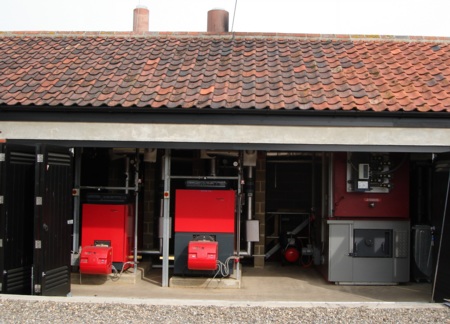Chimney automation systems make green biomass heating achievable

Strict adherence to the Government’s guidance notes on flue sizing and not understanding the performance capabilities of modern biomass boilers can jeopardize biomass heating projects, as Peter Roege explains.
A new housing development within the historic and beautiful Grade II listed Snape Maltings complex near Aldeburgh in Suffolk, famous as the home of Benjamin Britten and Peter Pears, includes a predominantly wood-fuelled community heating system with biomass boilers. The development has 19 ecologically friendly homes built into the historic listed buildings, and the biomass heating system fuelled by chipped wood makes sense because there is no mains gas supply but a reliable source of chipped wood fuel is only two miles away.
Because of the Grade II listing, the scheme needed Listed Building Approval as well as Planning Approval. A newly constructed central boiler house was required — but Listed Building Approval stipulations insisted that the new building looked like an original outbuilding. The boiler house was therefore designed with a basement for fuel storage and a single storey above ground, with a pitched roof and a chimney at the ridge, like ‘The Forge’ nearby.
The design and dimensions of the boiler house were agreed with the local authority, and TGA Consulting Engineers provided a performance specification for the boiler plant and flues. Specialist Flue Service, based in Nayland, near Colchester, was engaged to work on the design. Recognising the potential for planning difficulties over the height of the flue, Specialist Flue Service incorporated an Exhausto chimney fan system into the design, a move that made it possible to achieve the flue-gas velocity and dispersion required for planning consent from a chimney at ridge height.
However, the local authority’s advisers were uncertain about the chimney fan system solution and wanted to insist upon a chimney with a minimum height of 10 m, which, to achieve the efflux velocities, would have meant a flue diameter of 160 mm. Specialist Flue Service demonstrated that dispersal and dilution from the 160 mm-diameter chimney would cause a dramatic reduction in boiler performance compared with the fan-assisted design. The tall chimney was also completely at odds with the requirements of Listed Building Approval.
Countrywide
These challenges are being repeated all over Britain as the carbon-neutral benefits of biomass boilers become better known and commercial and industrial organisations seek planning permission for their installation. But getting planning permission is not easy. Planning authorities follow Government guidance notes about stack height, flue-gas velocity and pollutant dispersion when considering applications. These Government guidance notes are not actually rules, just suggestions of ways to meet the requirements of the Clean Air Act 1993. The snag is that authorities treat them as absolute rules.
However, the guidance notes are badly out of date and do not allow for the high efficiency of biomass boilers or the predictable flue velocity of modern chimney-automation systems. The Clean Air Act requires that the height of a boiler’s flue, or exhaust stack, must be approved. To give approval, local authorities look for guidance in the Clean Air Act 1956, The Clean Air Act Memorandum of 1991 and in the Technical Guidance Note D1 (dispersion) where guidance is given regarding calculation of chimney/stack heights to ensure efflux velocities to ensure efficient dispersion of high pollution emissions such as in process plant. Unfortunately, the low flue-gas temperatures from efficient biomass boilers cannot generate flue gas velocities that comply with the requirements of the Clean Air Act.
The suggested calculation is based on outdated values for particulate and assumed flue-gas temperatures of older, less-efficient boiler technologies that allowed more heat to escape up the chimney. Today’s biomass boilers are far more efficient. Consequently, the chimney-height calculations recommended in the guidance notes do not produce the stipulated efflux velocity. Councils often ask for dispersion modelling, but this is dauntingly expensive and often fails to produce a workable solution.

Cost implications
In the end, applicants often find it cheaper to abandon biomass and its benefits and go a traditional route. Yet, the Exhausto approach adopted by Specialist Flue Service at Snape Maltings achieves the efflux velocity recommended by the advice note, optimises the efficiency of the boiler and reduces the height of the stack to improve the appearance of the building. All that is needed is for planners to understand and accept that guidance notes are not rules and that Exhausto chimney-automation systems provide the planners with the flue velocity they need to pass the application and the building owners with the boiler efficiency they require if they are to save money and help the environment by burning biomass.
Exhausto chimney automation systems not only guarantee the efflux velocity but also ensures that the correct chimney draught is maintained at all times. Advanced electronic control ensures that exactly the right amount of draught is applied to meet the exact requirements of the boiler.
With a biomass boiler and the guaranteed optimum combustion conditions that result in a dramatic decrease in particulate and smoke, combined with an increase in fuel efficiency brought about by a chimney automation system, the building owner can finally get what he expects whilst keeping his green credentials.
Peter Roege is managing director of Exhausto UK.







